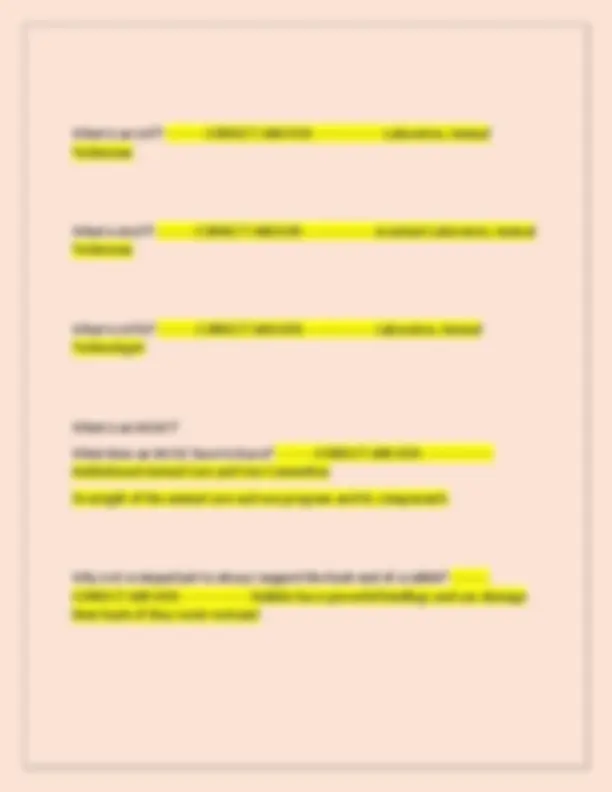






















Study with the several resources on Docsity

Earn points by helping other students or get them with a premium plan


Prepare for your exams
Study with the several resources on Docsity

Earn points to download
Earn points by helping other students or get them with a premium plan
Community
Ask the community for help and clear up your study doubts
Discover the best universities in your country according to Docsity users
Free resources
Download our free guides on studying techniques, anxiety management strategies, and thesis advice from Docsity tutors
The "Laboratory Animal Science Exam 2025" PDF is a comprehensive resource for students preparing for exams in laboratory animal science. This document provides a complete set of questions and verified answers, ensuring a thorough understanding of key concepts in the field. Topics covered include the significance of biological research features such as cheek pouches, which are unique due to their immunologically privileged status. The PDF also delves into essential terminology and practices, such as the use of transport cages, the Animal Welfare Act (AWA), and the role of the United States Department of Agriculture (USDA) and Animal and Plant Health Inspection Service (APHIS) in overseeing animal welfare. Students will gain insights into the care and handling of various laboratory species, including mice, rats, hamsters, guinea pigs, gerbils, and chinchillas.
Typology: Exams
1 / 28

This page cannot be seen from the preview
Don't miss anything!





















What value in biological research are cheek pouches? ---------CORRECT ANSWER--- --------------A biological difference existed between malignant and nonmalignant tissues What is a transport cage? ---------CORRECT ANSWER-----------------A small portable boxes, crates, or cages used to transport small animals What is the AWA? ---------CORRECT ANSWER-----------------Animal Welfare Act What governing body oversees the AWA? ---------CORRECT ANSWER----------------- The United States Department of Agriculture (USDA) and Animal and Plant Health Inspection Service (APHIS) What is SPF? ---------CORRECT ANSWER-----------------Specific pathogen free
Gerbil Gestation Length ---------CORRECT ANSWER----------------- 24 - 26 days (if lactating, delayed implantation up to 42 days) Guinea Pig Gestation Length ---------CORRECT ANSWER----------------- 59 - 72 days (average, 68 days) Hamster Gestation Length ---------CORRECT ANSWER----------------- 15 - 16 days What species requires a dust bath? ---------CORRECT ANSWER----------------- Chinchilla What does BID stand for? ---------CORRECT ANSWER-----------------Twice a day or every 12 hours What does HSUS stand for? ---------CORRECT ANSWER-----------------Humane Society of United States What does - emia stand for? ---------CORRECT ANSWER-----------------Blood
What is an LAT? ---------CORRECT ANSWER-----------------Laboratory Animal Technician What is ALAT? ---------CORRECT ANSWER-----------------Assistant Laboratory Animal Technician What is LATG? ---------CORRECT ANSWER-----------------Laboratory Animal Technologist What is an IACUC? What does an IACUC have to have? ---------CORRECT ANSWER----------------- Institutional Animal Care and Use Committee Oversight of the animal care and use program and its components Why is it so important to always support the back end of a rabbit? --------- CORRECT ANSWER-----------------Rabbits have powerful hindlegs and can damage their backs if they resist restraint
What vaccines do we routinely give ferrets? - --------CORRECT ANSWER----------------
What does AALAS stand for? ---------CORRECT ANSWER-----------------American Association for Laboratory Animal Science Which teeth are open-rooted in the rabbit? ---------CORRECT ANSWER----------------
How to convert kg to g? ---------CORRECT ANSWER-----------------Multiply by 1000 How to convert g to kg? ---------CORRECT ANSWER-----------------Divide by 1000 List 3 characteristics of good quality animal bedding: ---------CORRECT ANSWER----- ------------Non-Edible Absorbent Inexpensive The 3 R's represent the three alternative methods for ensuring the welfare of laboratory animals. We will use a topical pain relief medication (proparacaine) while performing venipuncture on rabbits. Which of the 3 R's does this pre- treatment address? ---------CORRECT ANSWER-----------------Refinement A female mouse delivers a litter of 8 mouse pups. Three days later, while handling the juvenile mice for the first time, the institution's technician is surprised to identify a prominent white area under the skin on the left ventral abdomen of the first pup. Should the technician be concerned? Why or why not ---------CORRECT ANSWER-----------------It is not worrisome as it is a milk spot
Mouse Type of estrous/ovulatory ---------CORRECT ANSWER----------------- Spontaneous polyestrus Rabbit Type of estrous/ovulatory ---------CORRECT ANSWER-----------------Induced Is the Rat affected by the Whitten Effect? ---------CORRECT ANSWER----------------- No Is the Mouse affected by the Whitten Effect? ---------CORRECT ANSWER-------------- ---No Rat Scientific Name ---------CORRECT ANSWER-----------------Rattus norvegicus Mouse Scientific Name ---------CORRECT ANSWER-----------------Mus musculus Rabbit Scientific Name ---------CORRECT ANSWER-----------------Oryctolagus cuniculus What is chromodacryorrhea?
When might you see this condition? ---------CORRECT ANSWER----------------- Excessive red tears from prophyrin When an animal gets stressed or ill. What is a conventional facility? ---------CORRECT ANSWER-----------------Consist of animal rooms and support areas that have single doors opening onto a central corridor. Normal sanitation measures are taken. Double-Corridor Facility. Sometime referred to as a clean/dirty facility. Where do we give IM injections in rabbits? ---------CORRECT ANSWER----------------- Epaxial or Caudal thigh Of the two locations of IM injections in rabbits which is typically preferred? --------
Of the macronutrients which has the most energy per unit of measurement? ------ ---CORRECT ANSWER-----------------Fats What is an essential nutrient? ---------CORRECT ANSWER-----------------Those that must be provided in the diet What does SQ stand for? ---------CORRECT ANSWER-----------------Subcutaneous What does IM stand for? ---------CORRECT ANSWER-----------------Intramuscular What does IP stand for? ---------CORRECT ANSWER-----------------Intraperitoneal How do we sex rats? ---------CORRECT ANSWER-----------------By the anogenital distance, males are 1 1/2 times longer than that of females What type of ovulator is a rat? ---------CORRECT ANSWER----------------- Spontaneous
Are Rats covered by the AWA (Animal Welfare Act)? ---------CORRECT ANSWER----- ------------No What is the common name for Chromdacryorrhea? What gland produces the chemical that causes this condition? What is the name of the chemical? When might you see this condition? ---------CORRECT ANSWER----------------- Chromodacryorrhea is an abnormally or excessive amount of red tear production. The red tears are colored by porphyrin which is created in the harderian gland. Chromodacryorrhea is usually seen when an animal is stressed or ill. Steps to Gavaging ---------CORRECT ANSWER-----------------1. Measure from the diastema to the most caudal rib
What teeth in the guinea pig are open rooted? ---------CORRECT ANSWER------------ -----All of the teeth What type of ovulator is the guinea pig? ---------CORRECT ANSWER----------------- Spontaneous Is the guinea pig covered by the AWA? ---------CORRECT ANSWER-----------------No What are some uses in research of guinea pigs? ---------CORRECT ANSWER----------- ------Cancer Toxicities Behavior Dematologcal pharmaceuticals What is pregnancy toxemia? How can it be treated? ---------CORRECT ANSWER----- ------------Pregnancy toxemia is a condition when the mother is in an negative energy balance due to the pups developing. The mother is not getting enough energy through food and metabolism to keep up. We treat this with glucose/nutrition supplementation.
How do we sex mice? ---------CORRECT ANSWER-----------------By the anogenital distance, males are 1 ½ X longer than that of females Guinea Pig IM injection ---------CORRECT ANSWER-----------------Restrain the animal appropriately. Place thumb of non-dominant hand on the vertebrae and index finger just behind the most caudal rib. Find the epaxial muscle and lift it against your thumb. With dominant hand, place syringe perpendicular to the muscle. You will need to move your hand slightly to look for blood when aspirating. Mouse SQ Injection ---------CORRECT ANSWER-----------------Restrain the animal appropriately Place the needle, using a cranial to caudal approach at a 40-45 degree angle into the scruff between the ears. What type of ovulator is a mouse? ---------CORRECT ANSWER----------------- Spontaneous Is a mouse covered by the AWA? ---------CORRECT ANSWER-----------------No What is a mouse used in research for? ---------CORRECT ANSWER----------------- Cancer
Rabbit IV Injection ---------CORRECT ANSWER-----------------Rabbit needs to be restrained in a mechanical restrainer or a towel. Ear is held in such a way that the rabbit cannot pull it out of the hand, and the needle can be placed with no angle. A tourniquet or hand is used to occlude the vessel. A small guage needle such as a 27g ½" is threaded into the caudal marginal ear vein distal to proximal direction. Once blood is seen in the hub, a hematocrit tube is placed into the hub to collect the blood. When blood is collected, the occlusion is released, digital pressure is applied and the needle is removed. The venipuncture site should be held for 20-30 seconds or until bleeding stops. What type of ovulator is a rabbit? ---------CORRECT ANSWER-----------------Induced Is the rabbit covered by the AWA? ---------CORRECT ANSWER-----------------Yes What are rabbits used for in research ---------CORRECT ANSWER----------------- Cancer Behavior Ocular Pharmceuticals
What is Snuffles? How can the clinical signs? Name the specific agent. --------- CORRECT ANSWER-----------------Snuffles is also called Pasteurellosis. It is an upper respiratory infection caused by Pasteurella multocida, a bacteria. Runny nose, crusty eyes and in advanced cases inner ear infections and circling is seen. True or False - The majority of non-human primates currently used in American research facilities are not wild-caught, but instead are bred and available through domestic suppliers. ---------CORRECT ANSWER-----------------True True or False - Non-human primate tuberculosis (TB) testing is usually performed via intradermal injection of TB antigen into the skin of the chest region. This is due to the ease of reaction visualization at this site. ---------CORRECT ANSWER------------ -----False, the eyelid A very contagious bacterial enteric pathogen occurs often in nun-human primate colonies. Pathogenesis of this disease involves bloody and mucoid diarrhea, resulting in fatigue and dehydration. Circle the correct etiology: ---------CORRECT ANSWER-----------------Shigella What is the term for a period of separation for animals newly introduced to a research facility where actions are completed (testing, isolation from the research colony, acclimatization to surroundings, etc) to ensure the addition of suitable individuals to the colony: ---------CORRECT ANSWER-----------------Quarantine